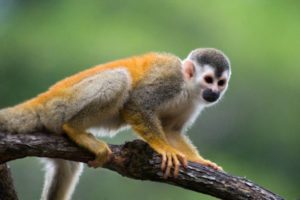Wildlife of Manuel Antonio
Costa Rica, a small country in Central America, is often celebrated for its incredible biodiversity of wildlife and lush landscapes. One of the jewels in its ecological crown is Manuel Antonio National Park, a captivating destination that boasts a stunning array of wildlife within its borders. From the treetops of its rainforests to the depths of its marine ecosystems, the park is a haven for both nature enthusiasts and those seeking an immersive experience in the heart of nature.
- Primate Kingdom
Manuel Antonio National Park is renowned for its vibrant primate populations. Among the most charismatic residents are the White-faced Capuchin monkeys. Recognizable by their expressive faces and prehensile tails, these intelligent creatures are often observed foraging for fruits, insects, and small animals, showcasing their resourcefulness.
Adding to the park’s primate diversity are the Mantled Howler monkeys, famous for their distinct vocalizations that resonate through the dense foliage. With their striking black coats and long, prehensile tails, they navigate the treetops with a grace that belies their size.
The park is also home to the playful Squirrel monkeys, recognized by their small size and endearing behaviors. Their acrobatics in the treetops bring smiles to the faces of visitors fortunate enough to witness their antics. And let’s not forget the endangered Central American Spider Monkey, an elusive and elegant creature with long limbs and a prehensile tail, highlighting the park’s role in protecting threatened species.
- Avian Wonders
Birdwatchers will find themselves in paradise within the confines of Manuel Antonio National Park. The park’s diverse habitats make it an ideal location for observing over 350 bird species. One of the most iconic inhabitants is the Scarlet Macaw, with its brilliant red, blue, and yellow plumage. The sight of these magnificent birds in flight against the backdrop of the lush rainforest is nothing short of breathtaking.
Toucans also grace the park’s skies, with their oversized, colorful bills and distinctive calls. The Keel-billed Toucan, in particular, stands out with its vibrant hues and peculiar vocalizations. The Fiery-billed Aracari is another toucan species that visitors might encounter, adding a touch of tropical exuberance to the landscape.
Hummingbirds, with their iridescent feathers and remarkable agility, are a common sight, especially around flowering plants. Their vibrant presence adds a touch of magic to the park’s already enchanting ambiance.
- Reptiles and Amphibians
Costa Rica’s reputation for harboring a diverse range of reptiles and amphibians is fully evident within the confines of Manuel Antonio National Park. The American Crocodile is a notable inhabitant of the park’s estuarine and mangrove areas. These impressive reptiles, while often elusive, offer a glimpse into the intricate web of life within the park’s aquatic ecosystems.
Lizards and iguanas are also part of the park’s repertoire. The Green Iguana, with its striking green coloration and impressive size, can often be seen basking in the sun. The Black Spiny-tailed Iguana is another common sight, using its strong tail to navigate the terrain.
The park’s amphibians, with their fascinating array of colors and patterns, are equally captivating. From the iconic Red-eyed Tree Frog to the tiny but vibrant Strawberry Poison Dart Frog, these creatures embody the park’s commitment to protecting its delicate ecosystems.
- Nocturnal Residents
As the sun sets, a new cast of characters takes center stage in Manuel Antonio National Park. Nocturnal mammals, such as the Kinkajou, emerge from their daytime hideouts to forage for food. Known as “honey bears” due to their fondness for nectar and fruits, these creatures are skilled climbers with a penchant for adventure under the cover of darkness.
Bats, despite their mysterious reputation, play a vital role in the park’s ecosystem. These creatures of the night are essential for pollination and insect control. Although they might not be as easily spotted as some of the park’s diurnal inhabitants, their presence is a testament to the park’s holistic approach to conservation.
- Marine Marvels
While the terrestrial wonders of Manuel Antonio National Park are awe-inspiring, its marine environments and inhabitants are equally captivating. With its location along the Pacific coast, the park encompasses both coastal and marine ecosystems. Snorkelers and divers are treated to vibrant coral reefs teeming with life, including colorful fish, graceful sea turtles, and even playful dolphins.
- A Call to Conserve
The awe-inspiring variety of animals that call Manuel Antonio National Park home underscores the importance of conservation efforts. As human activities continue to impact natural habitats around the world, protected areas like this play an indispensable role in preserving biodiversity. The park stands as a testament to Costa Rica’s dedication to environmental stewardship and its commitment to ensuring that future generations can continue to marvel at the wonders of the natural world.
In conclusion, Manuel Antonio National Park is a true testament to Costa Rica’s remarkable biodiversity. From the charismatic primates that swing through the trees to the vibrant birds that fill the skies, the diverse reptiles and amphibians that inhabit the forest floor, and the mysterious creatures of the night, the park offers a glimpse into the intricate web of life that thrives within its boundaries. As visitors explore its trails and coastlines, they become part of a legacy of conservation and appreciation for the incredible array of life that graces this corner of Central America.


 +1 888-818-2097
+1 888-818-2097
 +506 8932-4731
+506 8932-4731